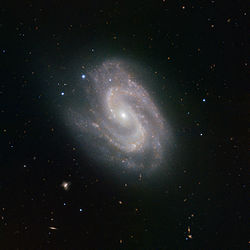| NGC 157 | |
|---|---|
 VLT image of NGC 157 | |
| Observation data (J2000 epoch) | |
| Constellation | Cetus |
| Right ascension | 00h 34m 46.751s[1] |
| Declination | −08° 23′ 47.36″[1] |
| Redshift | 0.0055[2] |
| Heliocentric radial velocity | 1651 km/s[3] |
| Distance | 39.4 Mly (12.1 Mpc)[3] 75 Mly (23 Mpc)[4] |
| Apparent magnitude (V) | 10.4[5] |
| Apparent magnitude (B) | 11.07[3] |
| Characteristics | |
| Type | SAB(rs)bc[6] |
| Size | 90 kly[7] |
| Apparent size (V) | 4.0′ × 2.4′[5] |
| Other designations | |
| MCG -02-02-056, PGC 2081, 2MASSX J00344675-0823473[2] | |
NGC 157 is an intermediate spiral galaxy in the constellation of Cetus, positioned about 4° east of the star Iota Ceti. This galaxy can be viewed from suburban skies using a moderate-sized telescope.[5] It was discovered on December 13, 1783 by William Herschel. The compiler of the New General Catalogue, John Louis Emil Dreyer noted that NGC 157 was "pretty bright, large, extended, between 2 considerably bright stars".[7] It is a relatively isolated galaxy; the nearest other galaxy of comparable luminosity lies at a separation of 4.2 Mly (1.3 Mpc).[8]

The morphological classification of NGC 157 is SAB(rs)bc,[6] indicating this is a weakly-barred spiral galaxy (SAB) with a transitional ring structure (rs) and moderate to loosely-wound arms (bc). The plane of the galaxy is inclined at an angle of 61.8° to the line of sight from the Earth.[6] It has symmetric arms that become flocculent in the outer parts, breaking into multiple arms. The rotation curve for this galaxy undergoes a sharp decline, suggesting a low mass or a small dark matter halo.[8] It is considered a quiescent galaxy, showing little star formation activity.[9] However, there is a starburst region in the nucleus forming new stars at the rate of about one solar mass per year.[10]
This galaxy has been host to two observed supernova events. The first, 2009em, was discovered 5 May 2009, about 34″ west and 10″ south of the galaxy core.[11] It was determined to be a Type Ic supernova.[12] On 5 May 2022, Type Ic supernova event SN 2022jli was observed in NGC 157, reaching a peak magnitude of 14.4.[13]
- ^ a b Cite error: The named reference
2MASSwas invoked but never defined (see the help page). - ^ a b Cite error: The named reference
simbadwas invoked but never defined (see the help page). - ^ a b c Cite error: The named reference
Tully_et_al_2016was invoked but never defined (see the help page). - ^ Cite error: The named reference
Moore_et_al_2023was invoked but never defined (see the help page). - ^ a b c Cite error: The named reference
O'Meara_2007was invoked but never defined (see the help page). - ^ a b c Cite error: The named reference
Crowther_2013was invoked but never defined (see the help page). - ^ a b Cite error: The named reference
cseligmanwas invoked but never defined (see the help page). - ^ a b Cite error: The named reference
Zobnina_Zasov_2020was invoked but never defined (see the help page). - ^ Cite error: The named reference
Zhu_et_l_2009was invoked but never defined (see the help page). - ^ Cite error: The named reference
Sempere_Rozas_1997was invoked but never defined (see the help page). - ^ Cite error: The named reference
Monard_2009was invoked but never defined (see the help page). - ^ Cite error: The named reference
TNS_2023was invoked but never defined (see the help page).